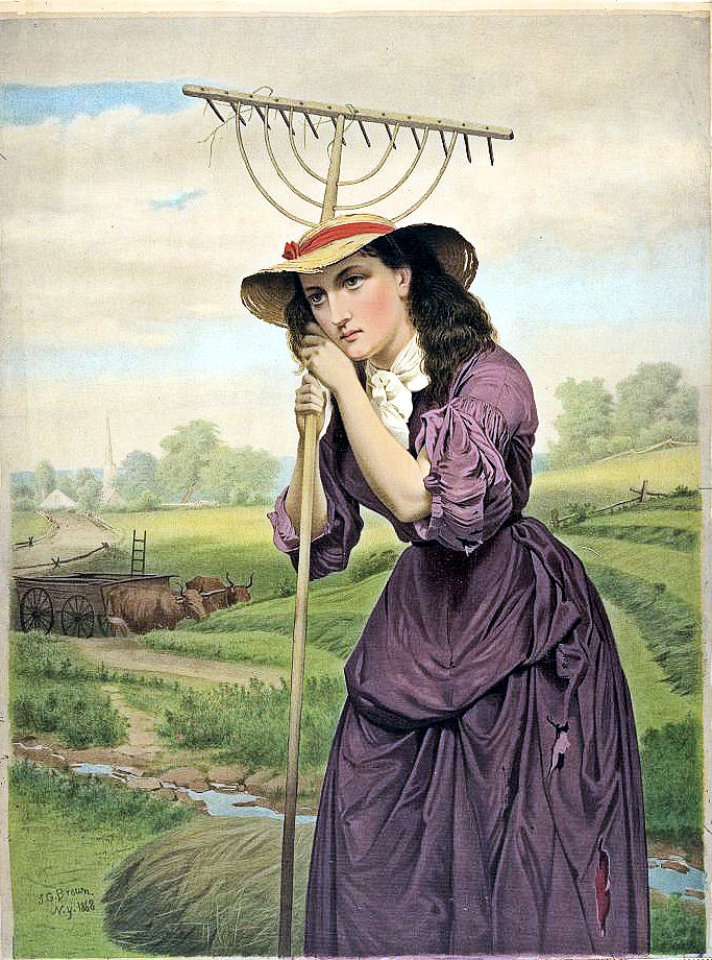
Even the most avid gardeners can struggle with how to wake up the late summer garden after a long, hot summer. August through September can be a tough time for gardens and gardeners alike.
Did you know there’s a term for this time of year, called serotinal? The word comes from the Latin adverb sērō (late)” and means ‘pertaining to or occurring in late summer.’ It’s the midpoint between mid-summer and autumn.
This is an awkward time in the garden, when things seem to have come to a screeching halt, and everything is a little muted.
Especially our plants with various shades of green that were once vibrant with notes of chartreuse, lime, and deep, rich greens that made the garden feel so lush.
Now, it seems these enthusiastic shades have been dulled by the heat, blending in with one another to create a less exciting garden.
And when combined with perennials that have called a time-out, taking a break from the unrelenting heat, it can be downright depressing strolling through the garden.
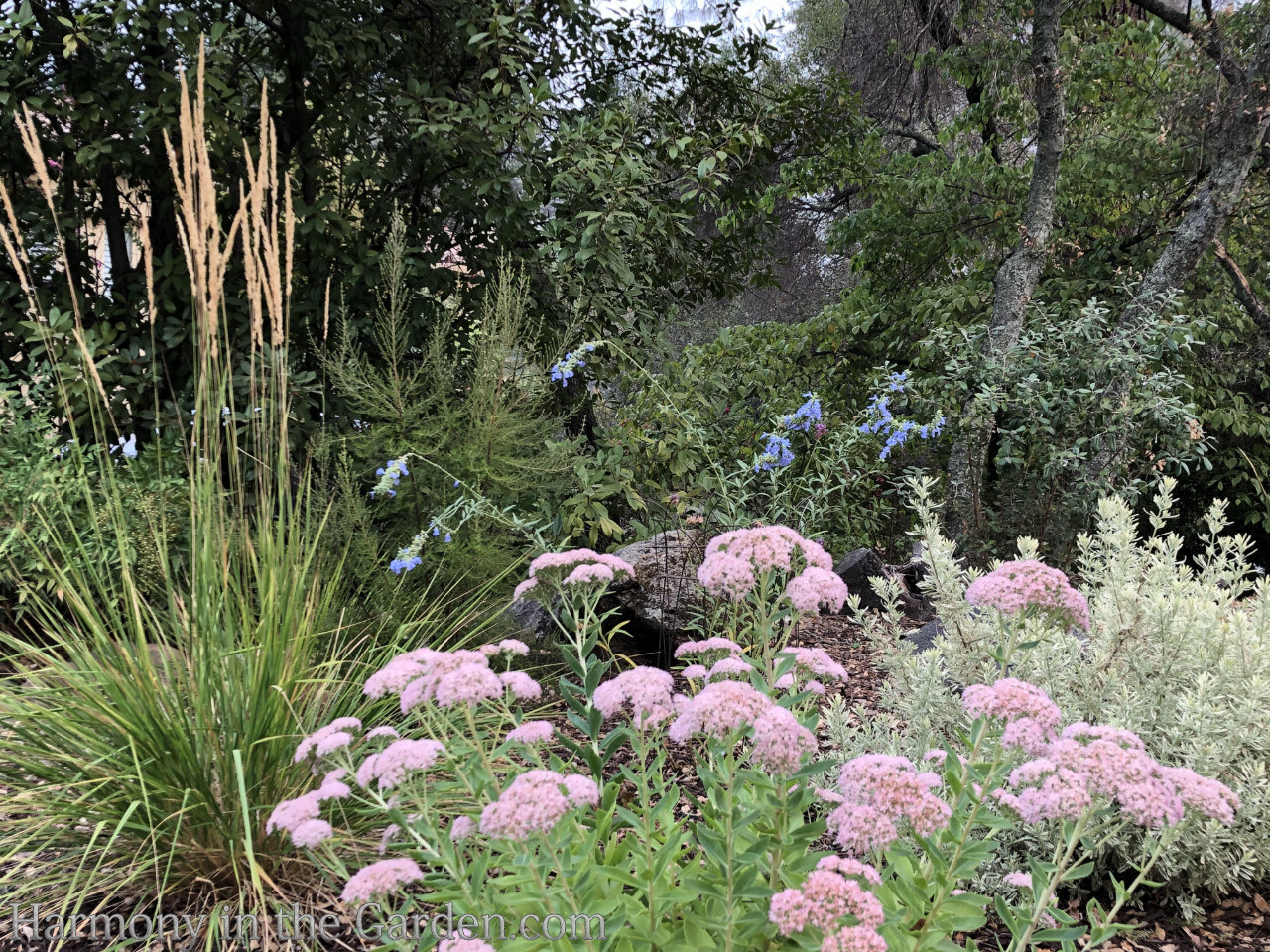
Fortunately, as hot and tired as I feel, my garden still has plenty of bright spots. Which is why I’ve updated this post to include loads of plants that come into their own when the others poop out.
I’m not talking about those plants that might produce a few token repeat blooms – I’m talking about plants that produce TONS of blooms.
Plants that not only tide the garden over until the cooler temps of fall put on their own show – but plants that thrive in this serotinal season (like this sedum ‘Autumn Joy’, left, which is just now starting to step on stage.)
So here we go!
Rudbeckias – Full to part sun, perennial, zones 3-9, deer-resistant
I adore all rudbeckias, reminding me of my grandmother’s zone-6 Lake Tahoe garden, where they grew with wild abandon. Here are some of my favorites.
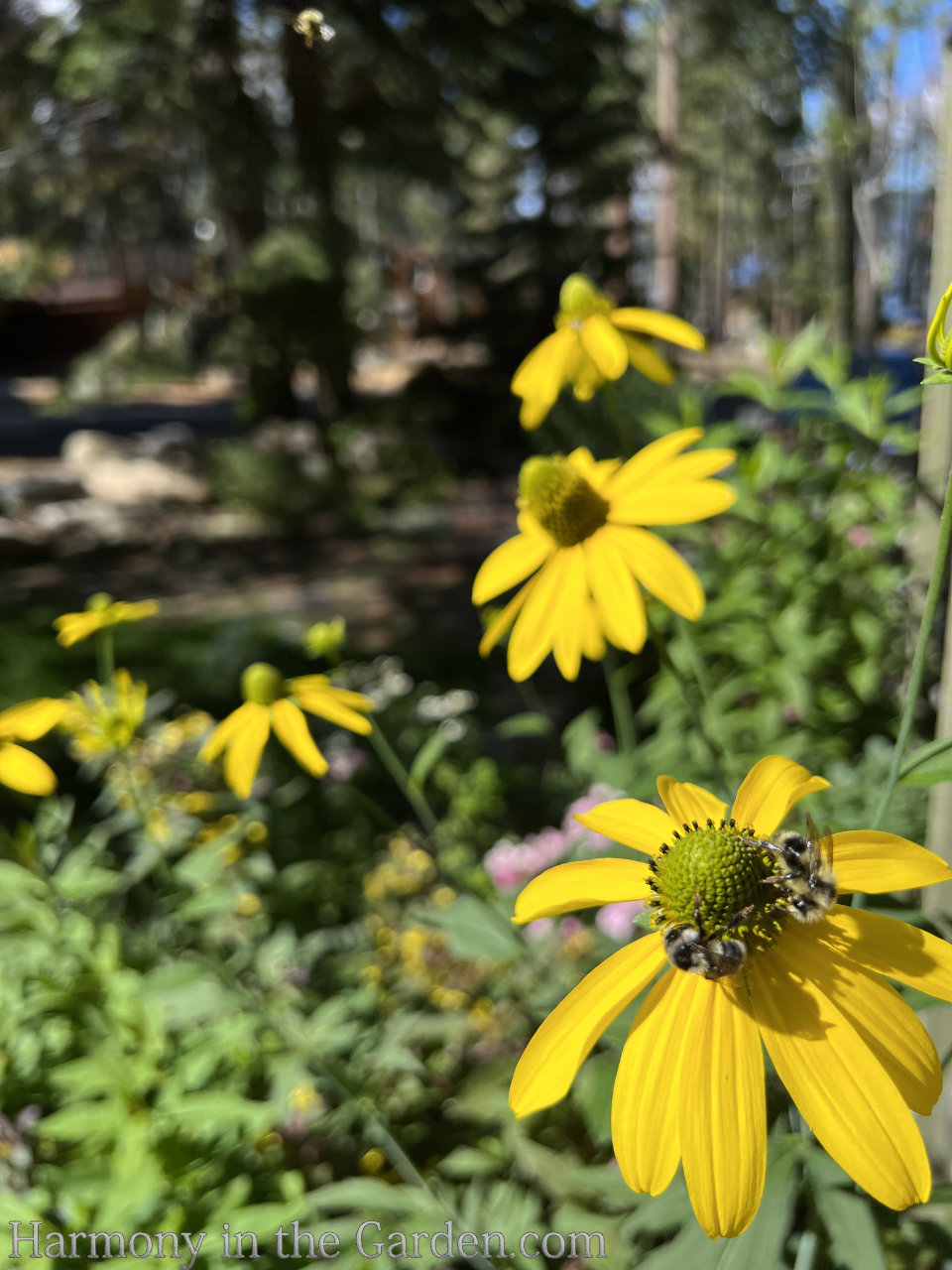
Rudbeckia laciniata (Cutleaf Coneflower)
Native to Missouri, this pollinator-favorite prefers more water, though it does well with average water at my family’s Lake Tahoe garden.
Plus, without ample water, its typical aggressiveness is easily curtailed, keeping this rampant spreader in check.
With average water, it grows to 4’x3’, but if grown with more water (or along a stream, where it’s really happy) it’ll definitely spread around and grow to 9’ tall!


Rudbeckia triloba ‘Prairie Glow’
Like the more common rudbeckia triloba (below), it also has a multi-branching habit, but instead of the typical gold-yellow blooms, these flowers glow with shades of mahogany, red, orange, and yellow.
Don’t the colors ‘pop’ when planted in front of burgundy foliage?
Once established, it grows to 36” x 18” and may re-seed if you’re lucky.
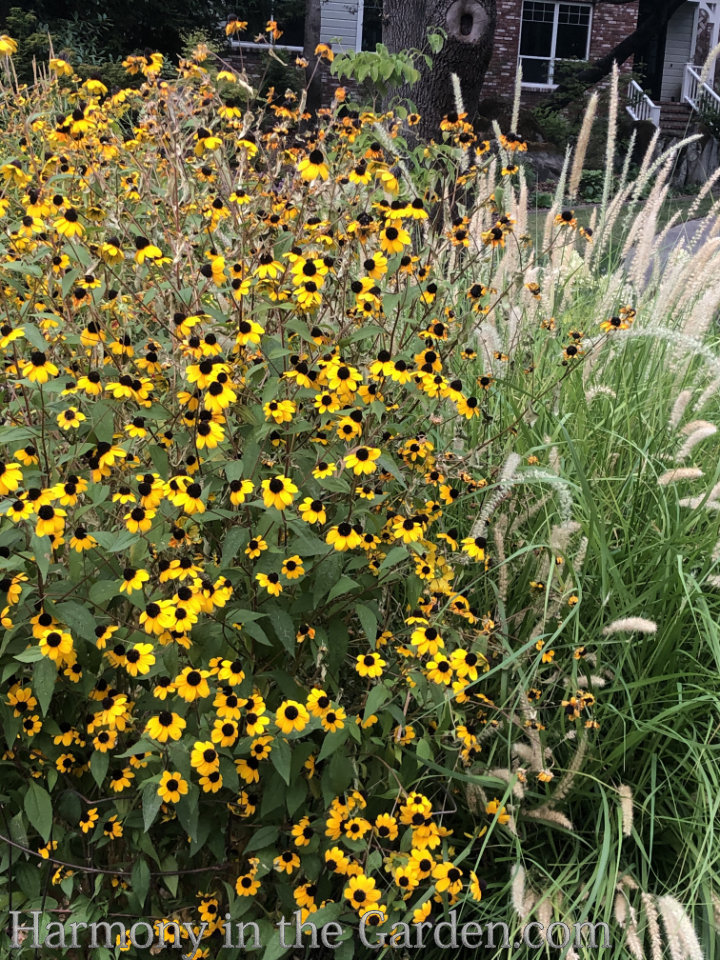
Rudbeckia triloba
This is the common variety, yet nonetheless just as spectacular as any other!
The 1-inch flowers cover the tall multi-branched stems, but what the flowers lack in size, they make up for in quantity.
It begins blooming mid to late-summer and will be covered with hundreds of blooms all the way through October.
If happy, it will re-seed throughout your garden, which I don’t mind, as rudbeckias can be short-lived.
And with so many babies sprouting up, I always have plenty to pass along.
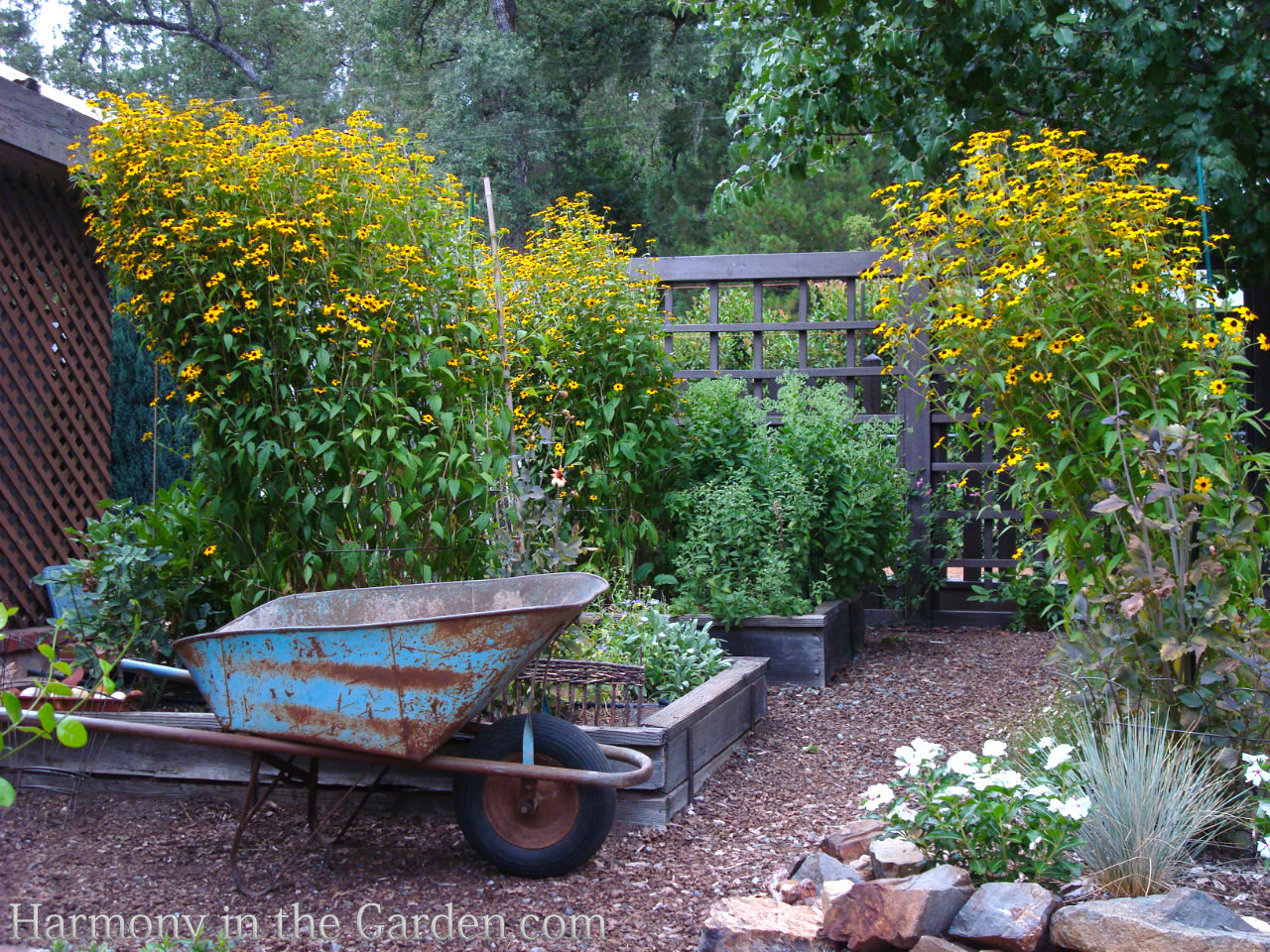

Rudbeckia ‘Henry Eilers’
I adore prairie plants, which is why when I first spotted this variety at the Bellevue Botanic Garden, I vowed then and there to find some for my own garden.
This is a tall variety, growing to 4-5’, with tons of starry golden-yellow late-summer blooms with spoon-shaped petal tips. Very unusual!
While I’ve never seen them available in local nurseries, I’ve ordered mine from Bluestone Perennials.
Even though the tags say they need moist soil, mine have done well with average water. I just make sure to provide at least 3-inches of mulch to help retain the moisture.
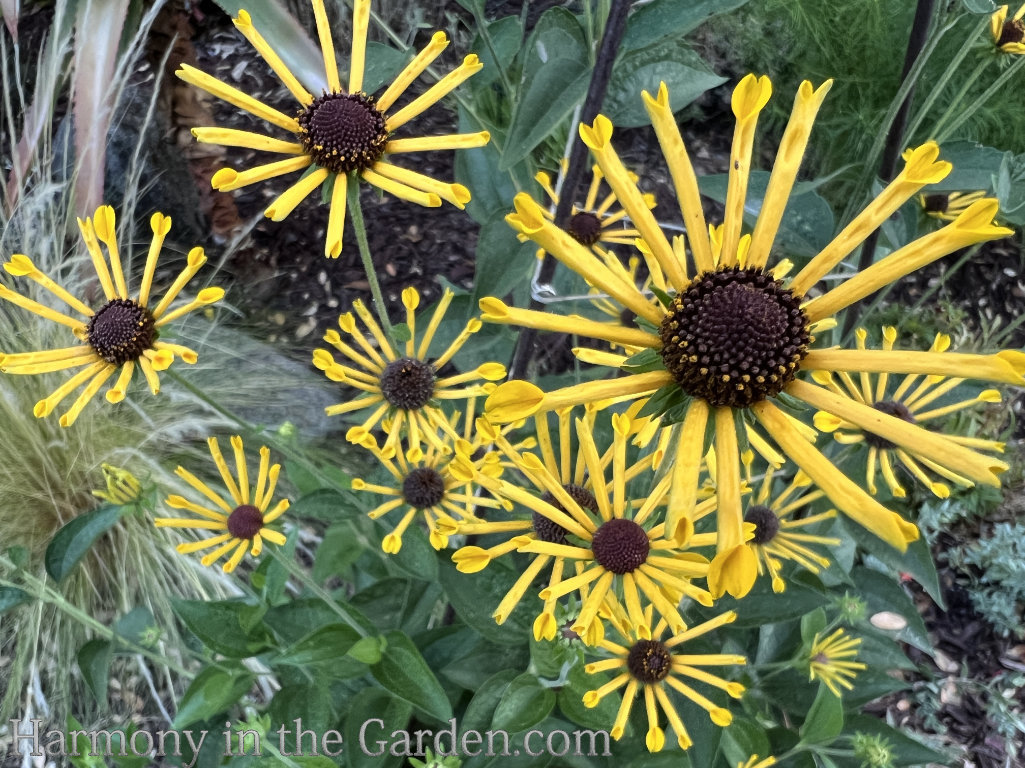
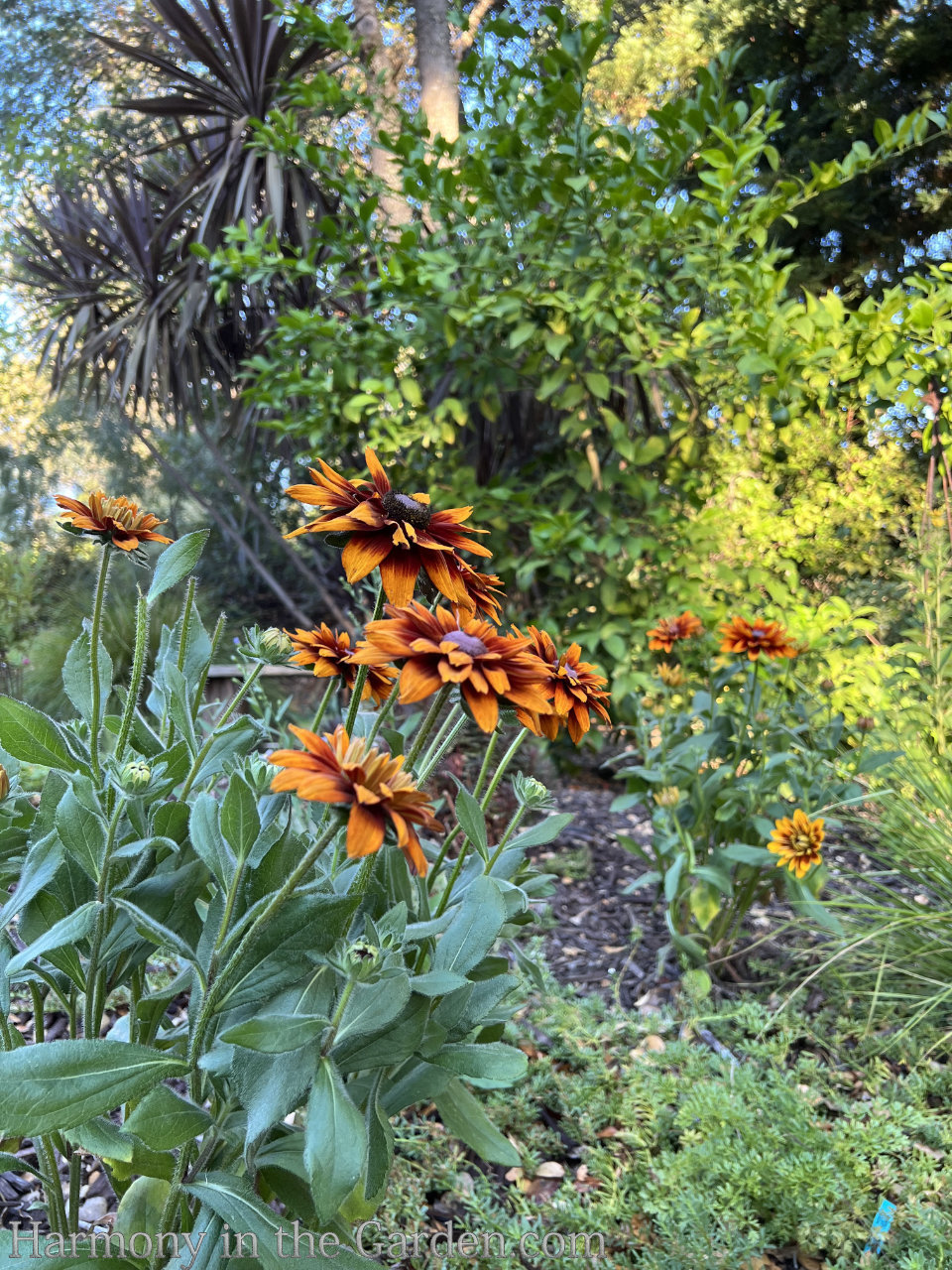
Rudbeckia hirta ‘Autumn Colors’
This is a full-sun, short-lived perennial (mine have lasted only 2-3 years), but boy, are they worth replacing when the time comes!
This native variety is much shorter than the others I’ve previously mentioned, growing to just 2’x2’.
The flowers, though, are much larger – 3 to 4”, in shades of deep orange, red, gold, and yellow.
Bouvardia ternifolia (Firecracker Bush) perennial, full to part-sun, zones 7-10, deer-resistant
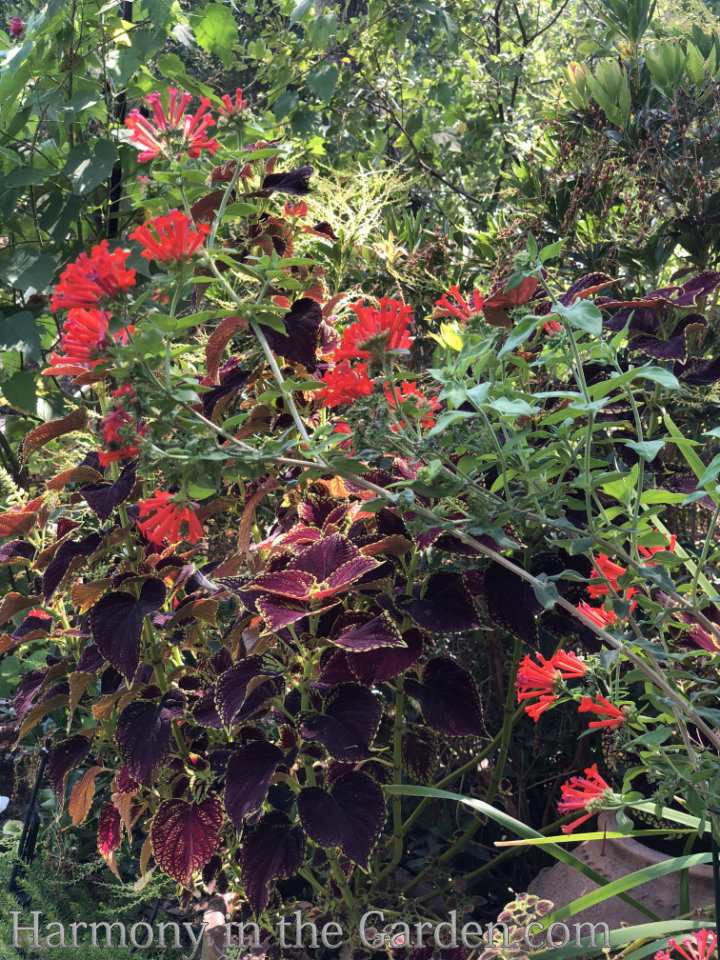
By far, the most popular post I’ve written is 25 Heat-Loving, Deer-Resistant Perennials for HOT Summer Days. So, if you’ve read that post you might see a few repeat performers in this post about late-summer blooming plants.
That’s because a few plants are THAT amazing – they keep pumping out the blooms for weeks on end, all the way through fall.
Bouvardia is no exception, as it looks just as good today as it did in July. Native to Texas (and the southwest) this is an amazing perennial that will attract every hummingbird in the area to your garden.
It has stiff, upright stems that reach 3-4 feet tall, and once the temps begin to heat up, the vibrant scarlet red flowers appear (and never stop until the first frost!)

Helianthus ‘Lemon Queen’ full-sun, perennial, zones 4-9, deer-resistant
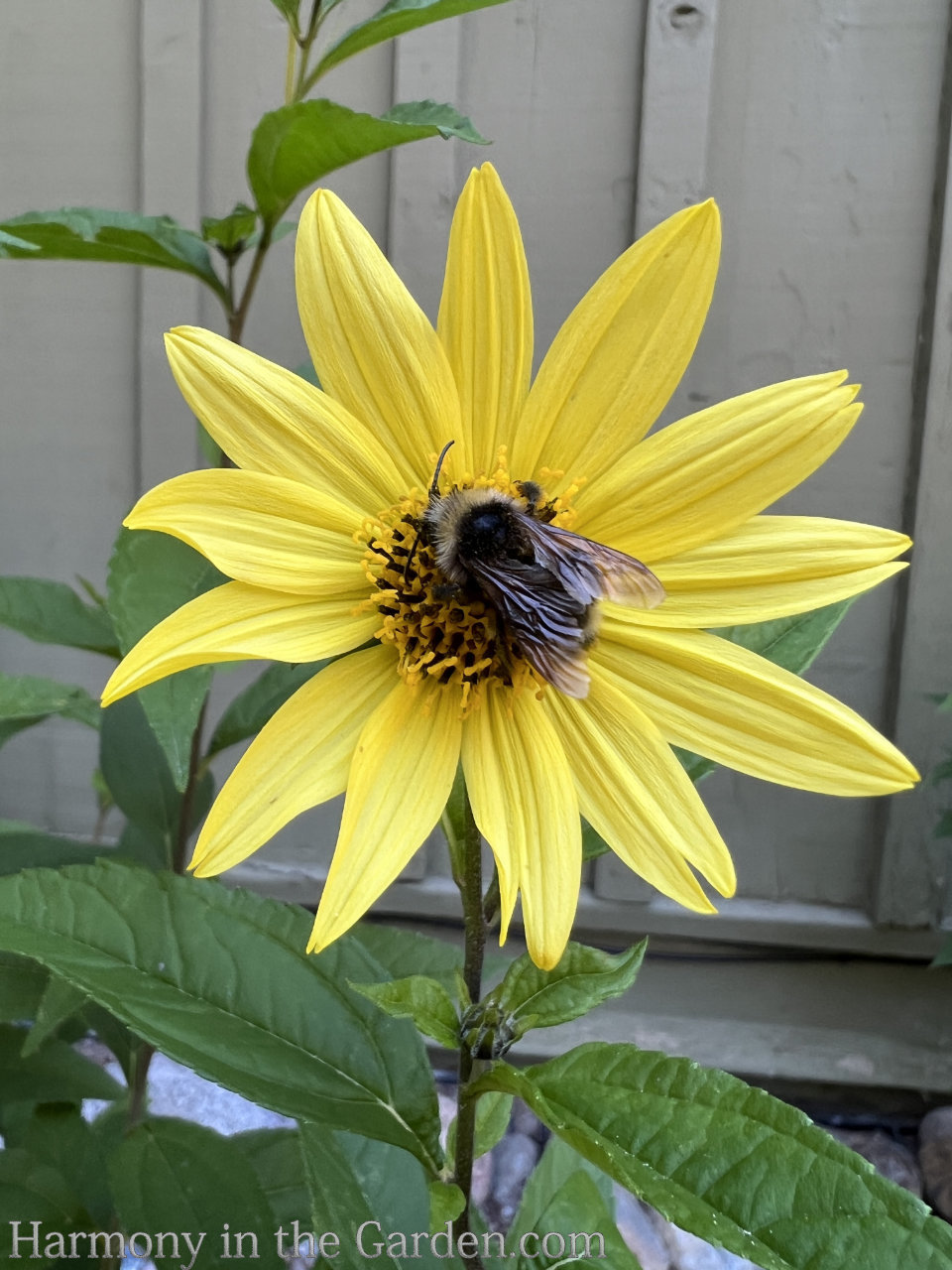
As some of my regular readers know by now, I’m a sucker for anything that grows unusually tall (click here for some of my favorites!), and I’m excited to say that ‘Lemon Queen’ doesn’t disappoint.
Give it a few years, and this perennial sunflower will grow to a towering 8’ x 4’, with loads of 2-3” soft yellow flowers, bringing lots of sizzle to your late summer garden.
This is a Midwest native variety of helianthus, preferring moist soil, but it does just fine in my garden with average water.
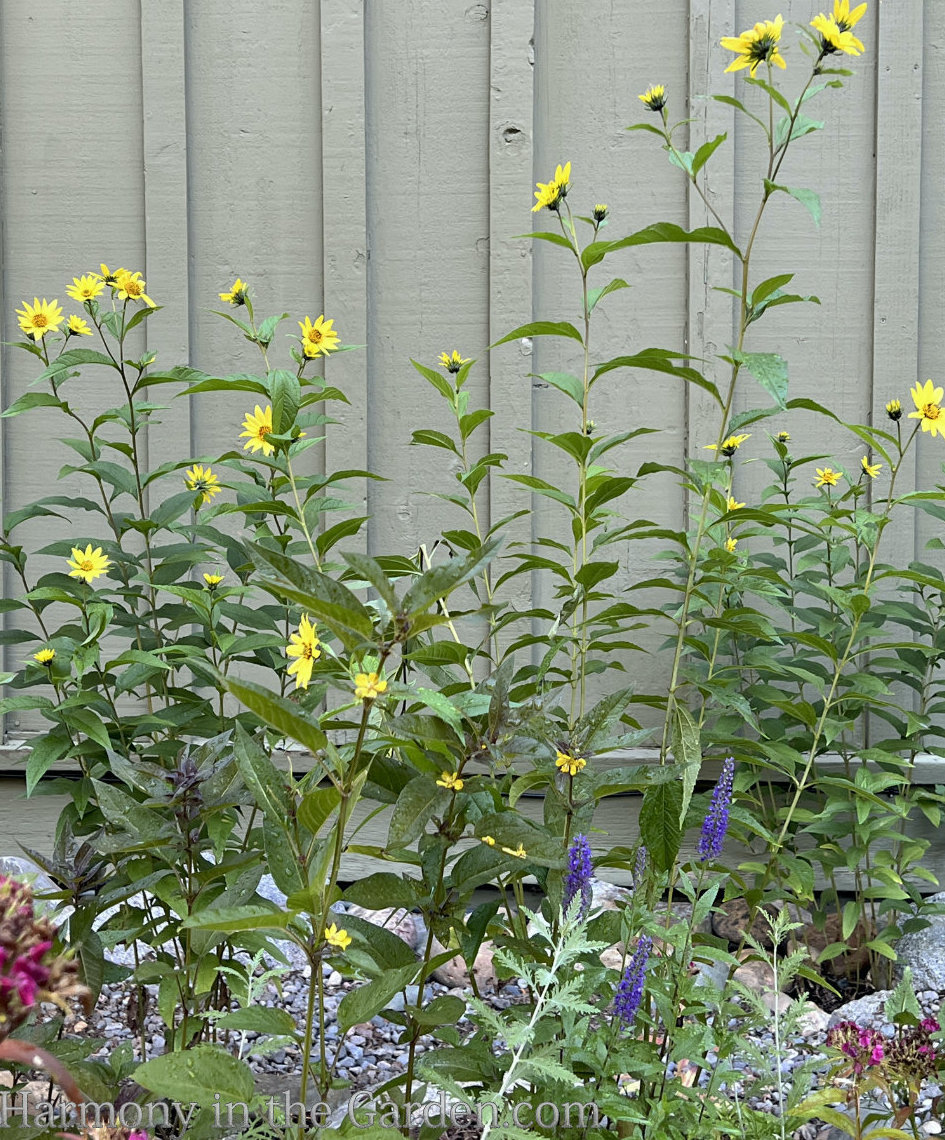
Asters
I have loads of aster varieties throughout my garden. They’re indispensable for blooming their little hearts out during this transitional time in the garden.
Anything that blooms for weeks at a time, nourishes tons of pollinators, and withstands marauding deer and rabbits has my vote!
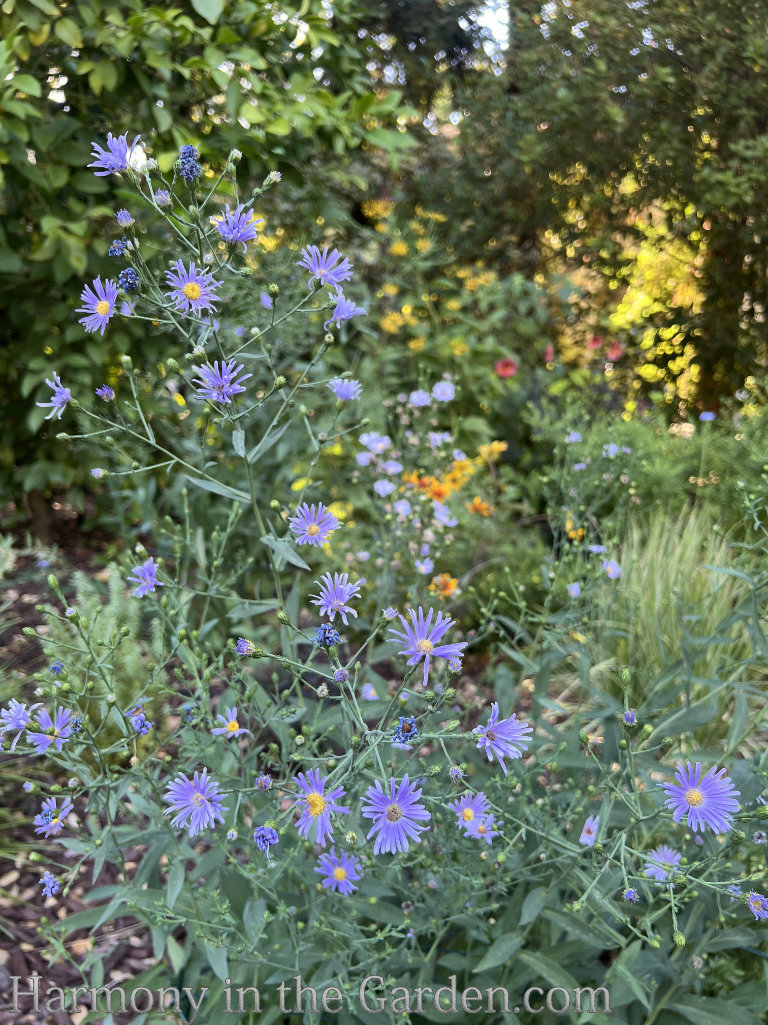
Aster laevis (Smooth Aster) zones 4-9
The Smooth Aster is unique in that it’s tall and airy looking. It quickly grows to 3-4’ on tough stems that don’t easily flop over.
Leaves are long and smooth to the touch versus other asters (hence its common name.)
But it’s not just the gorgeous little blue-lavender flowers that make my heart beat a little faster – look at the fantastic glaucous foliage! (click here to read about other glaucous favorites)
The foliage holds up throughout the HOT summer, never showing signs of being burnt or crispy.
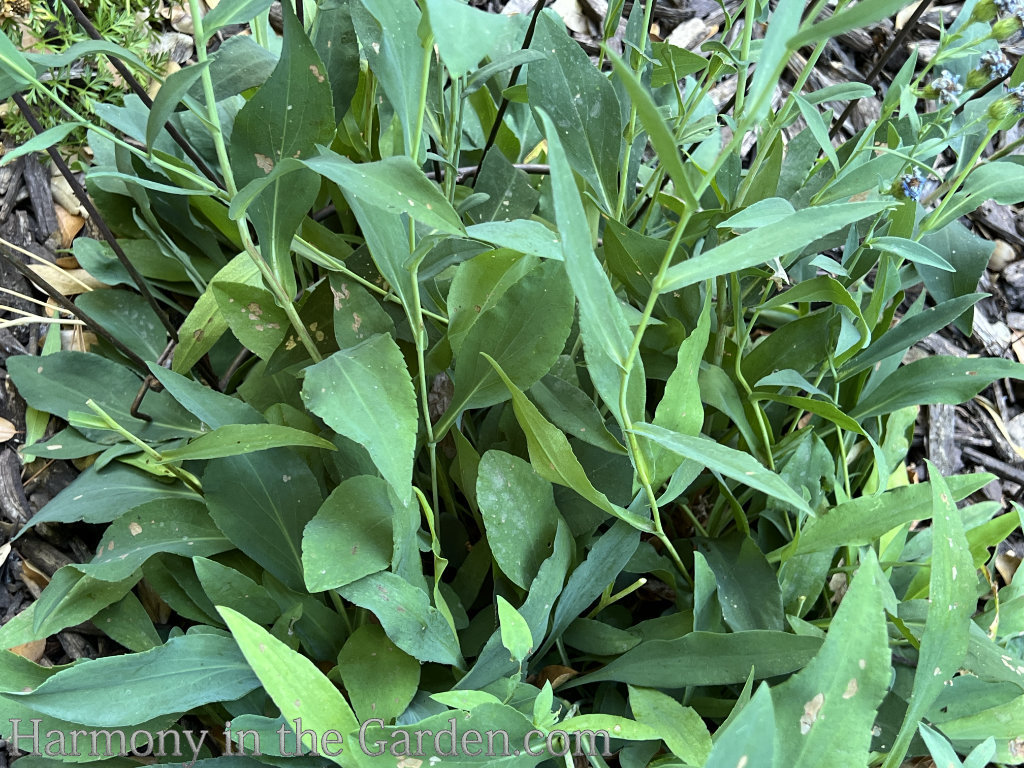
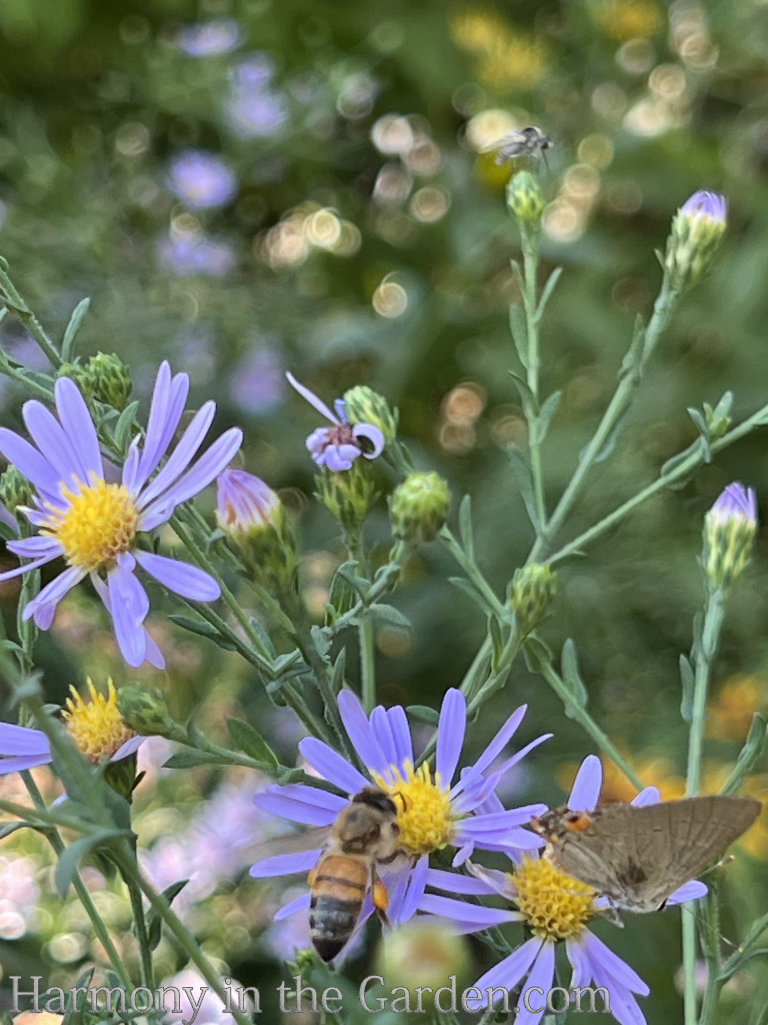

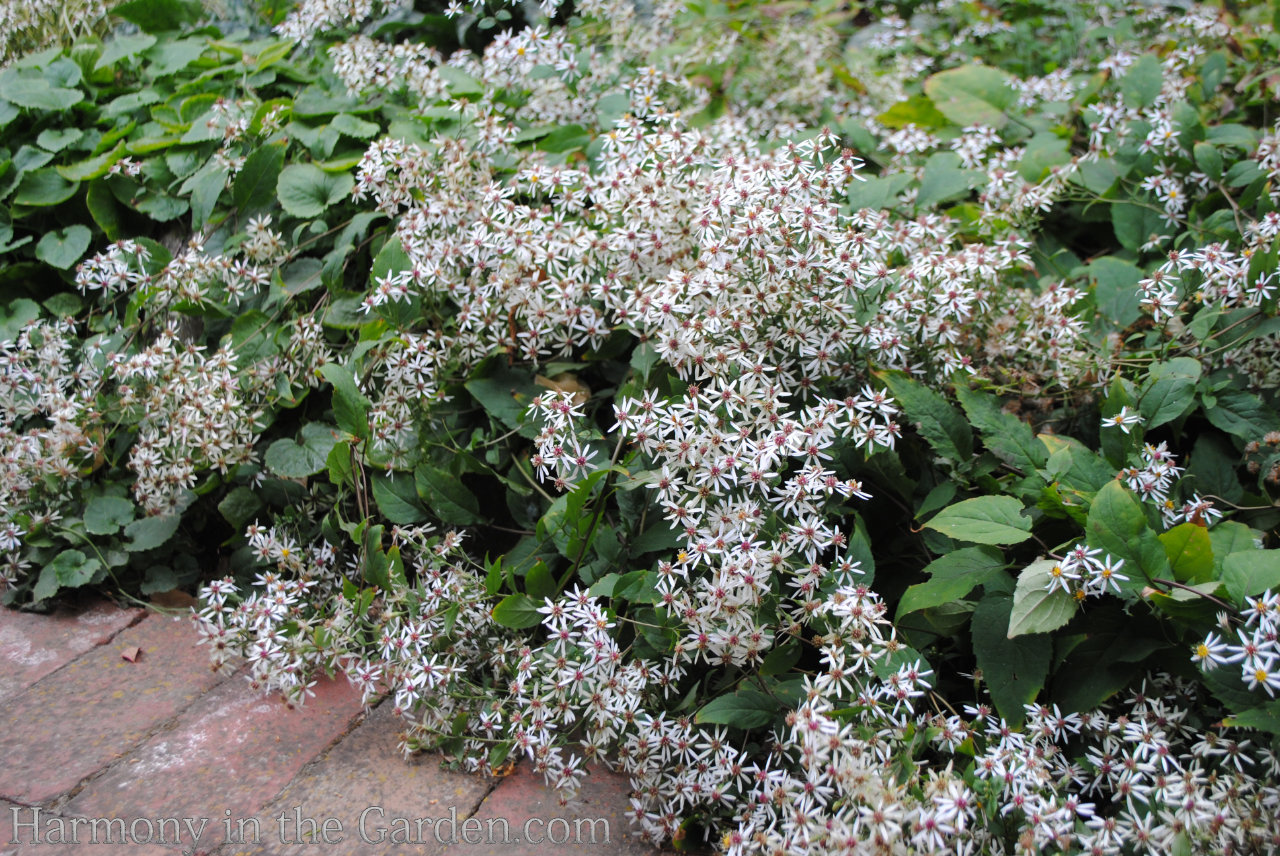
Aster divaricatus (Wood Aster) zones 3-9
This is my favorite groundcover aster, perfect for cascading down a rock wall.
The Wood Aster prefers shade, with a bit of morning sun to encourage blooms.
Despite the internet saying it’s somewhat thirsty, in my gardens in Los Altos, Granite Bay, and Lake Tahoe, it thrives with fairly low water.
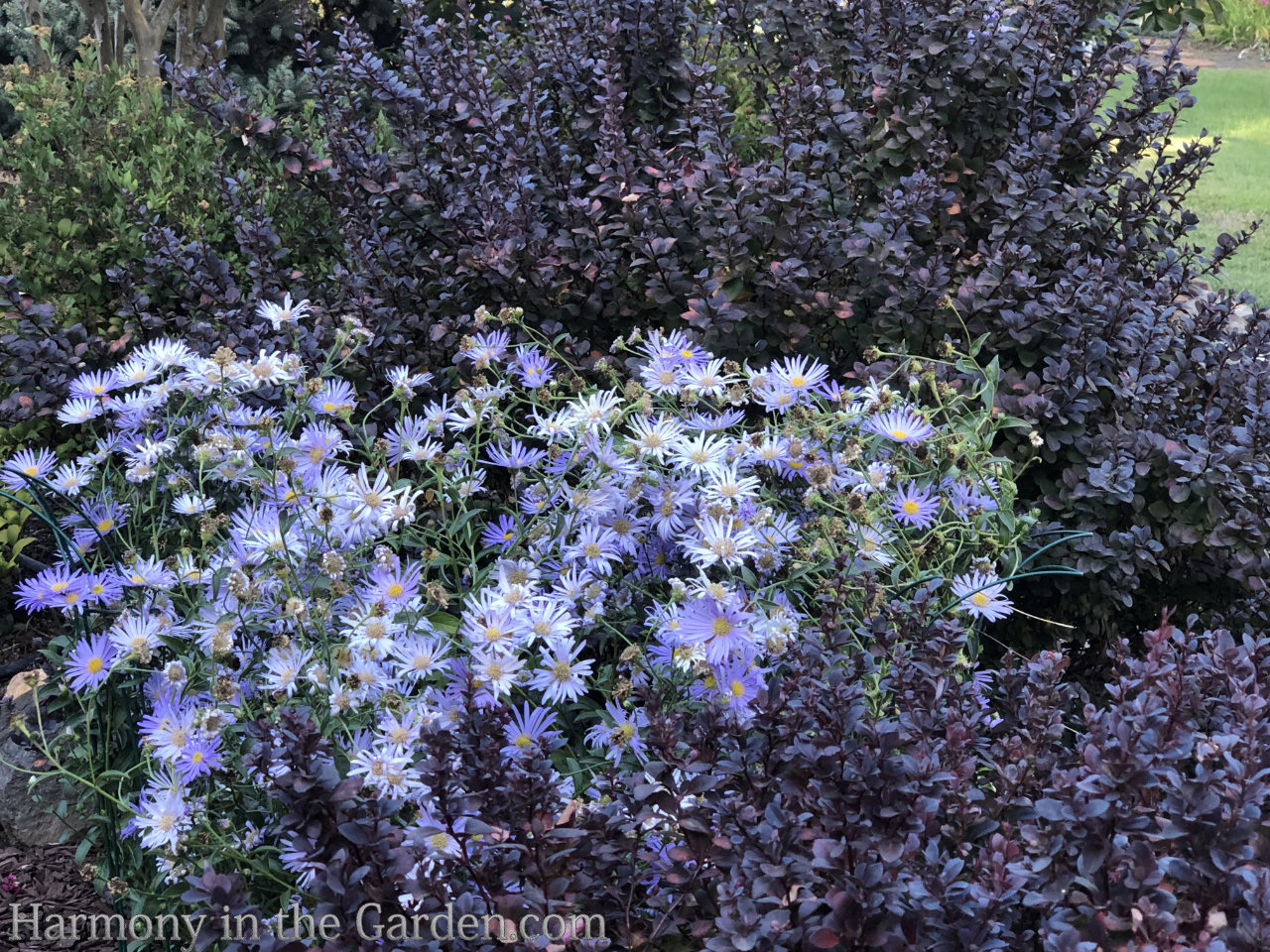
Aster frikartii ‘Monch’ zones 5-9
I have several of these throughout my garden, most in full sun but some in partial shade (fewer flowers, but heck, at least they bloom!)
They look particularly stunning nestled among the dark foliage of Berberis ‘Concord.’
In fact, maroon and glaucous/blue is one of my favorite color combos (click here to see why!)
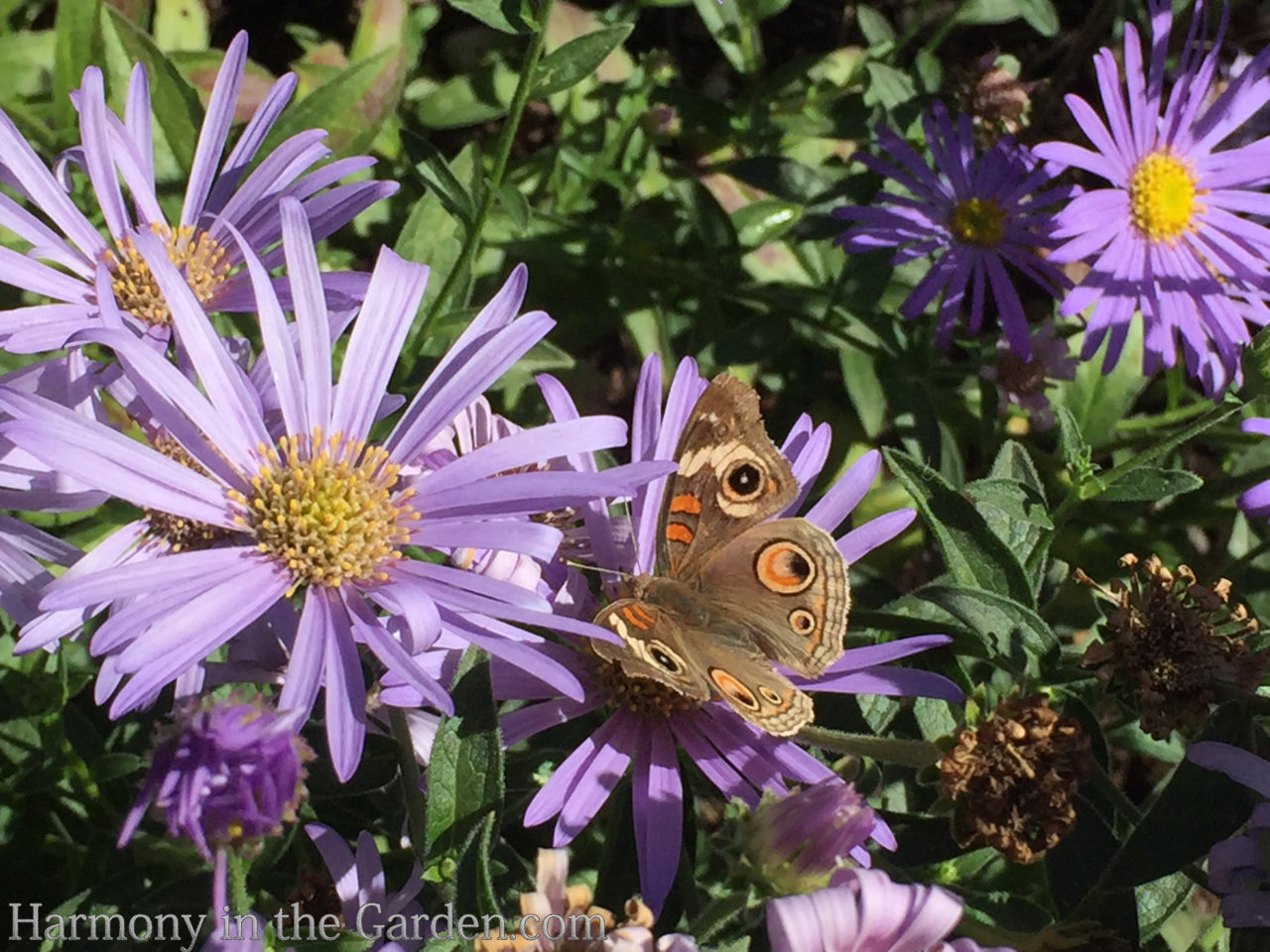
Blooming from July through September, I think the butterflies love them almost as much as I do.
Oh, and don’t be so quick to cut back the spent flowers of ‘Monch’ as they can add another element of interest to the winter garden (below.)
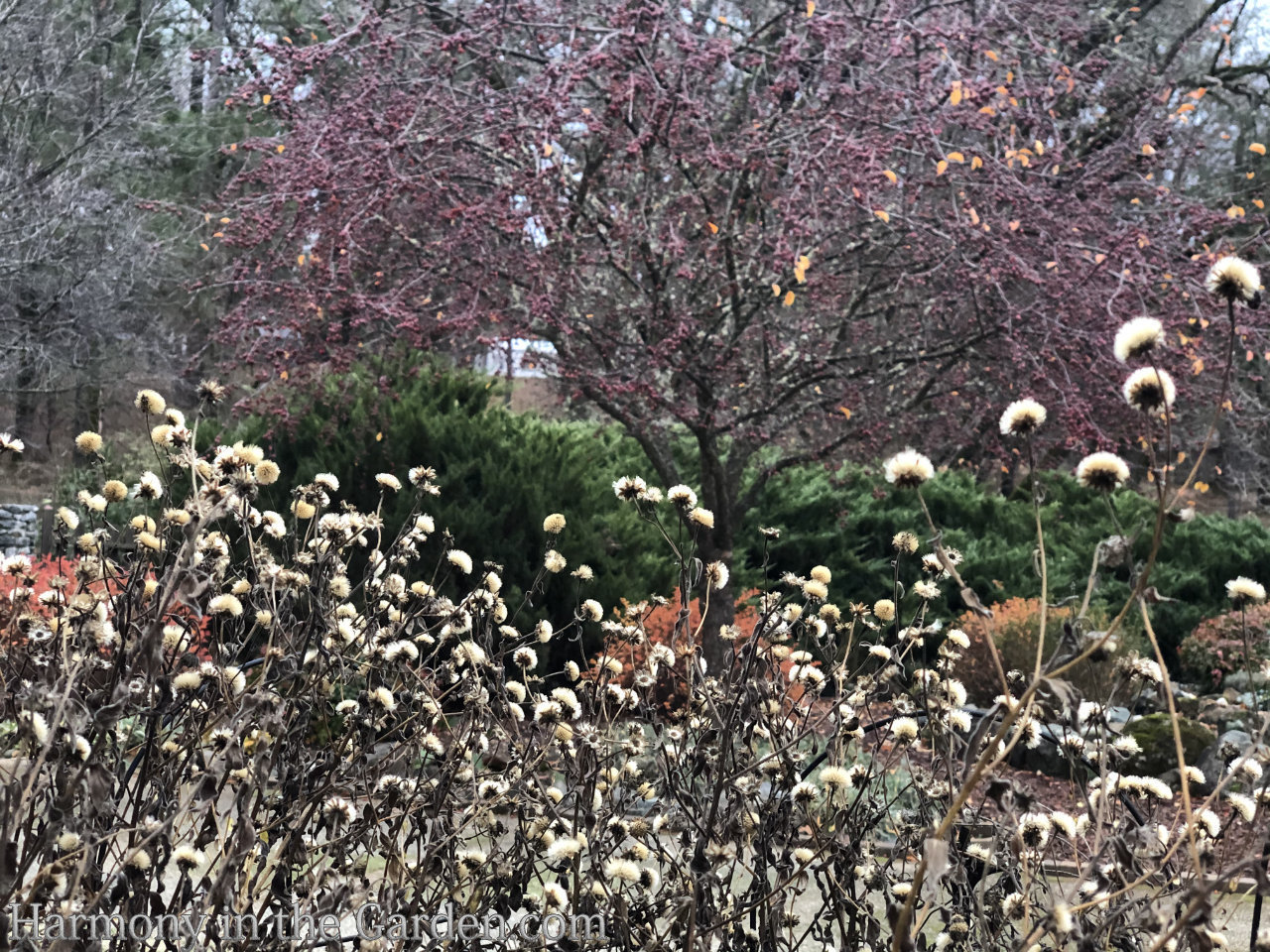
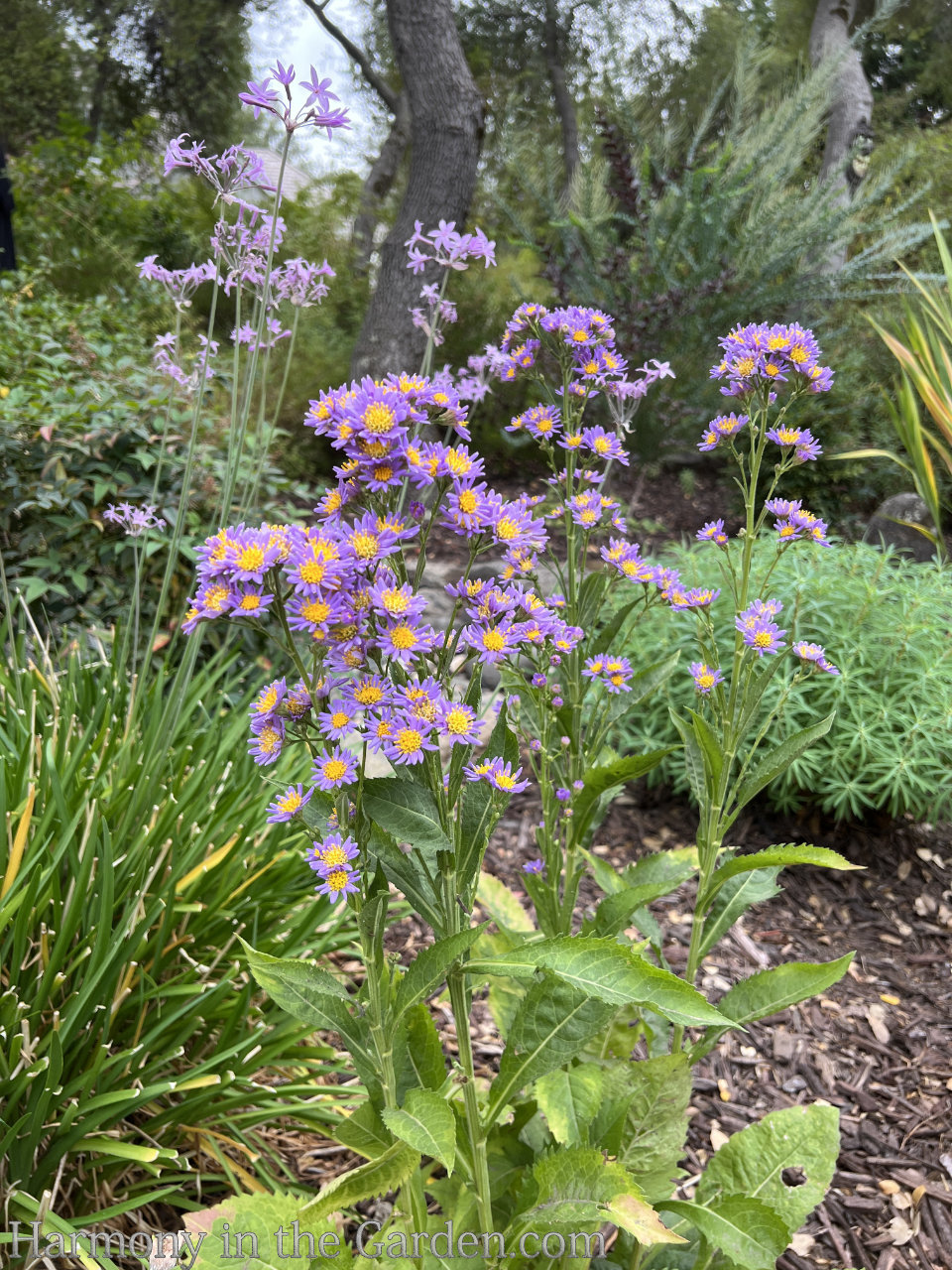
Aster tataricus ‘Jindai’ (Tatarian Aster) zones 5-8
I’m always experimenting with zone-8 plants, praying they’ll do well in my zone-9 garden. Sometimes they do, sometimes not so much.
Luckily, this Tatarian Aster loves my garden!
However, it does want a bit more water (similar to the New England Aster, below) so I have this one planted at the bottom of the hill where a naturally occurring high water table keeps it watered for me.
While the species grows to a towering 7-8′, ‘Jindai’ tops out at 3-4′ on very stiff stems, making it ideal for the middle of the border.
The profuse purple blooms of ‘Jindai’ start opening towards the end of September, and last until the first frost, making it a fantastic early-fall food source for hungry pollinators.
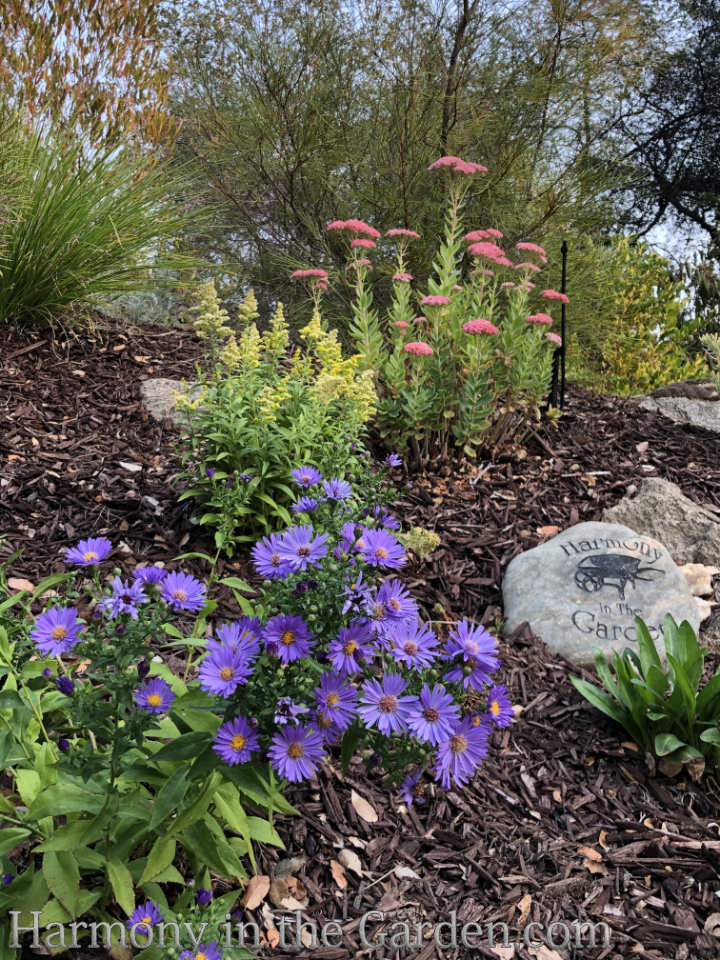
Aster ‘Barbados’ (New England Aster or Michaelmas Daisy) zones 5-9
This variety is a bit thirstier than the others (after all, it’s called a ‘New England’ aster which is a clue!) but it still does really well in my garden with moderate water. In the photo (left) you can see it growing with yellow solidago ‘Little Lemon’ and sedum ‘Autumn Joy – two other amazing late-summer bloomers.
And below, it’s also growing behind my agave desmetiana.

Malvaviscus arboreus (Turk’s Cap) deciduous shrub, part-sun, zones 7-10

This native shrub has been in my garden for several years, providing rich nectar to every hummingbird in the neighborhood.
While it does die back in the winter, it can quickly grow to 8-feet or more in a single season, if it has moderate water.
I give mine less water than it probably wants, which keeps it growth at a manageable 4’x4′.
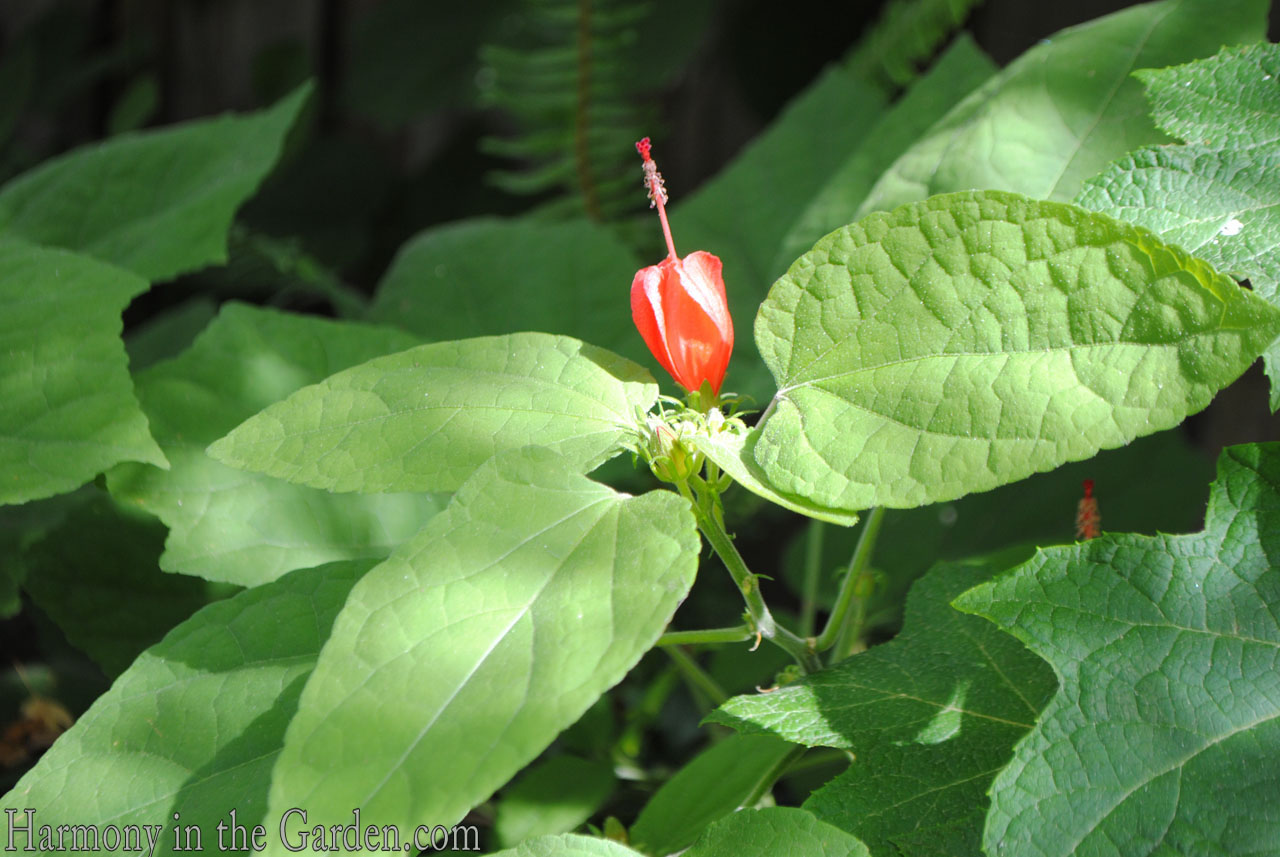
Ornamental Grasses
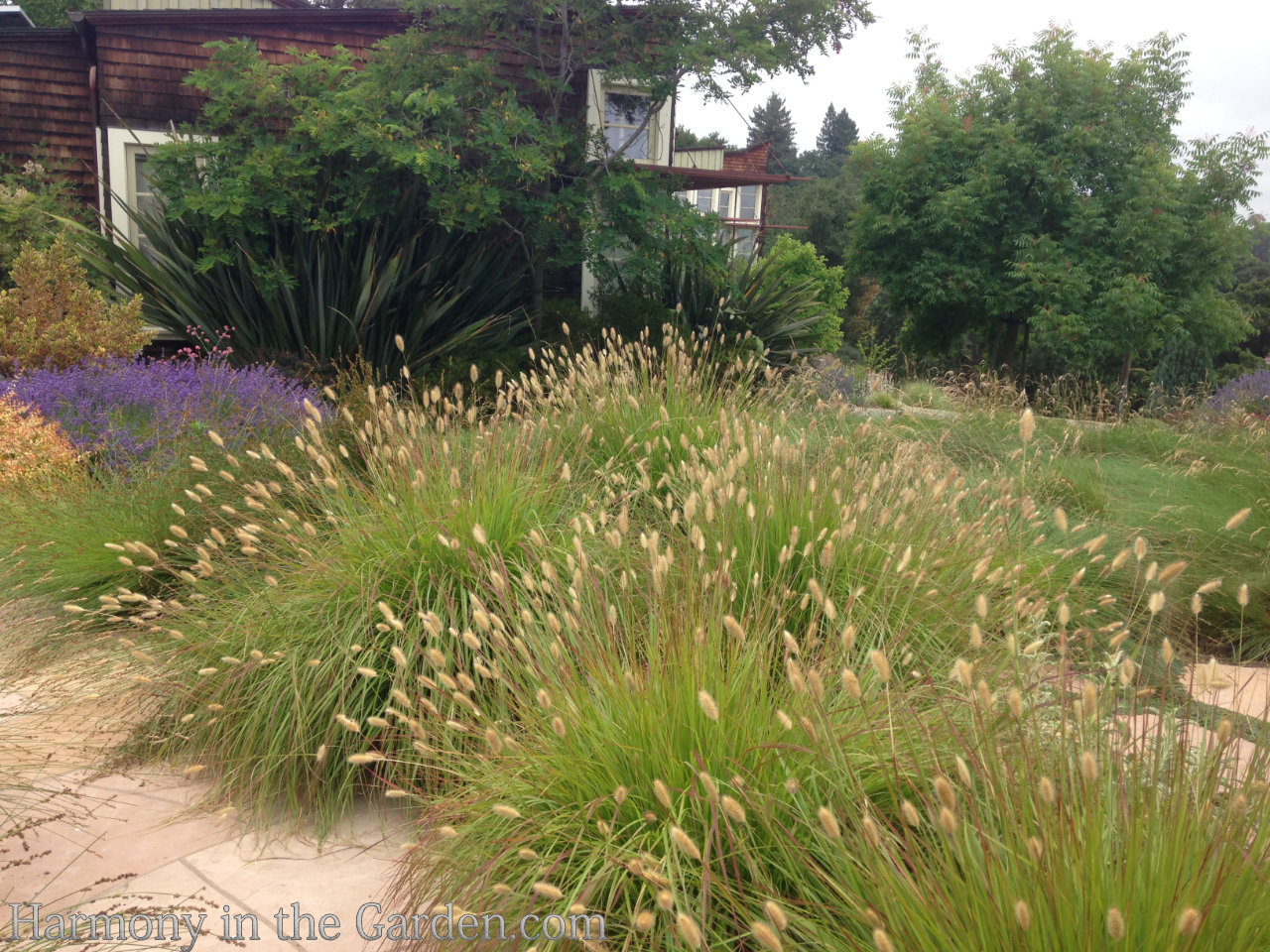
Of course, I’d be remiss if I didn’t include ornamental grasses in this post about adding pizzazz to the late-summer garden.
Many grasses, like the calamagrostis, pennisetum, or betula varieties are just now starting to ‘bloom’ with their tall inflourescens.
However, in this post, the focus is on flowers.
But if you’d like to read more about how to design with ornamental grasses, and the many gorgeous varieties that have thrived in my garden – click here.
Zauschneria ‘Everett’s Choice’ (CA Fuchsia) perennial, full-sun, zones 8-11, deer-resistant

Man, oh man, my California Fuchsias are in their prime right now!
‘Everett’s Choice’ is my go-to variety of choice, as the foliage tends to have a greenish tint to it (versus many other varieties that have glaring, steely-gray foliage.)
Combine that beautiful foliage with the tiny scarlet, red-orange trumpets that cover the 1 1/2′ mound, and you have a hummingbird’s buffet.
This particular planting combination gets all-day sun, with reflected heat from my driveway. The zauschneria, lomandra ‘Platinum Beauty’, and grevillea ‘Peaches and Cream’ (behind) is perfection, looking good throughout the majority of the year.
What more could you want?

Caryopteris ‘Beyond Midnight’ and ‘Dark Knight’ (Bluebeard) perennial, full-sun, zones 5-9, deer-resistant

‘Beyond Midnight’ (left) is a Proven Winners variety and is still one of my favorite late-summer bloomers.
Starting in late July, this Bluebeard will bloom through the end of September.
The blooms are darker than many other varieties, and the shrub is more compact.
I wish you could see how many bees are on this plant (look closely, and you can find at least 4!)
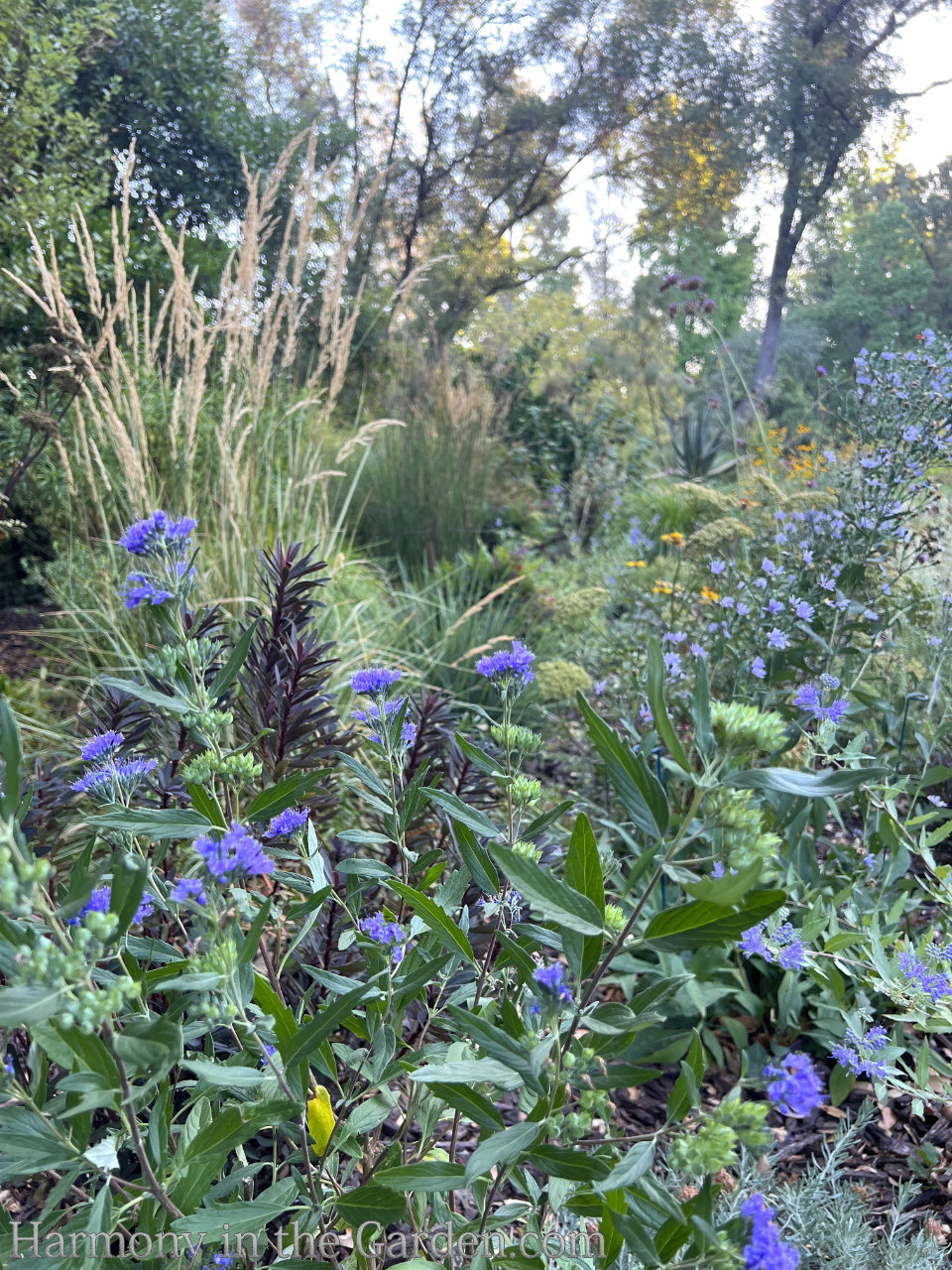
This is the ‘Dark Knight’ variety which grows a bit taller (3’x3′) than ‘Beyond Midnight’ (2’x2′).
I love the repetition of blue colors happening in this combination, with the aster laevis (mentioned above) growing behind.
If you squint, you can even see the salvia azurea in the distance, further echoing the cool blue colors.
Tithonia rotundifolia ‘Goldfinger’ (Mexican Sunflower) annual, full-sun, zones 8-11, deer-resistant

I love orange flowers in the garden (click here to see some of my favorites), and tithonia doesn’t disappoint.
It’s mid-September now, and my tithonias are just now kicking into gear, with loads of buds waiting to open into 3” bright orange flowers that light up the garden.
It’s a tall annual, quickly growing to 48” (or more) x 20”, and does well with average water. I’ve heard it can be a little tricky to start from seed (anyone have experience?), but I’m definitely going to try it this year.
Vitex agnus-castus (Chaste Tree) perennial, full-sun, zones 5-9, deer-resistant
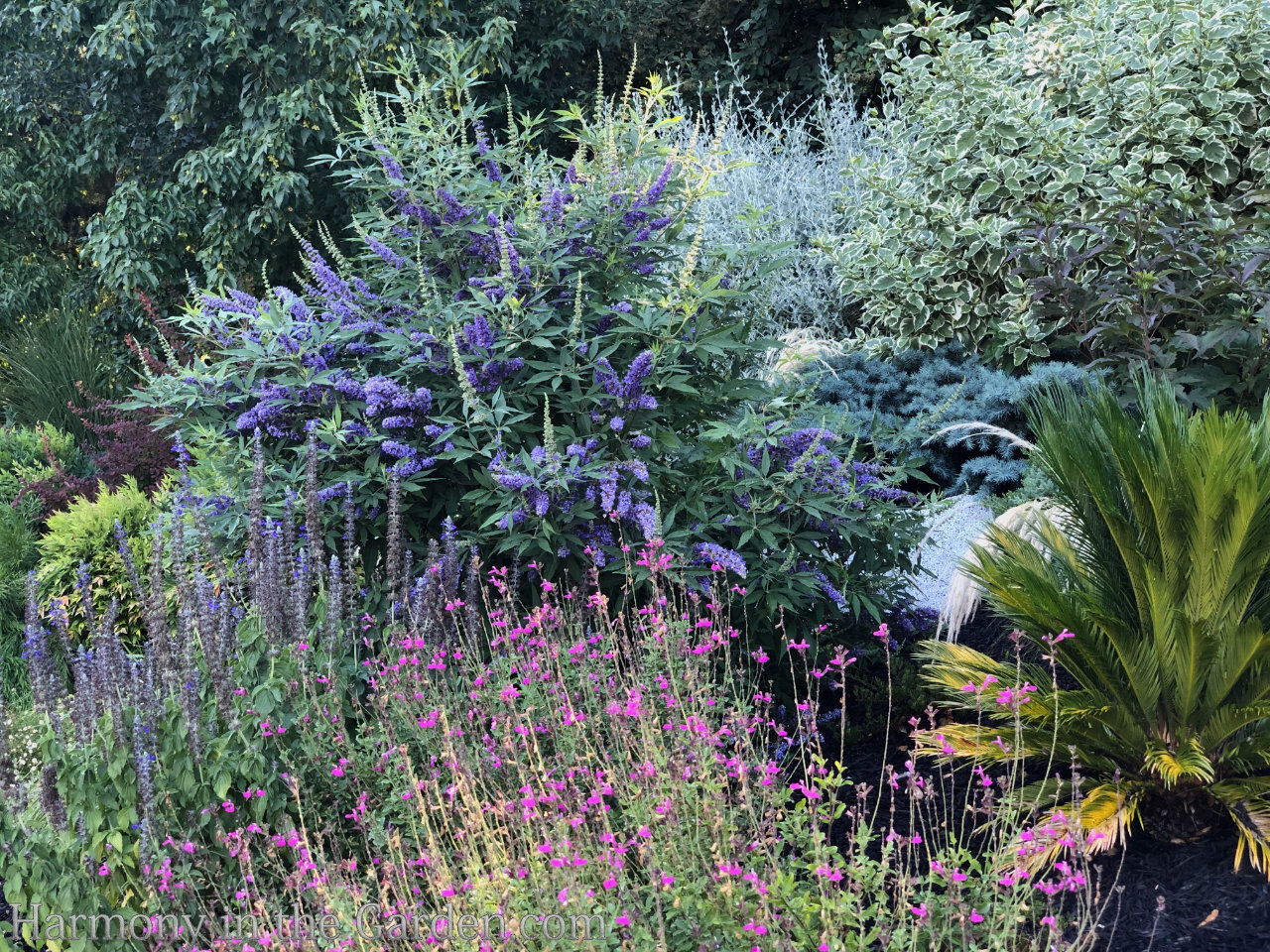
The vitex is a non-stop bloomer, starting in July and going all the way through to the first frost.
In this photo, it’s the large shrub with lavender-colored blooms, behind the bright pink salvia.
It’s a biggie, growing into a large shrub/small tree (15’x15’ or more!)
However, ‘Blue Diddley’ is a smaller Proven Winner variety that I’m dying to get my hands on, growing to a much more manageable 5’x5’.
Lantana, tender perennial in zones 9-11, otherwise an annual, full-sun, deer-resistant
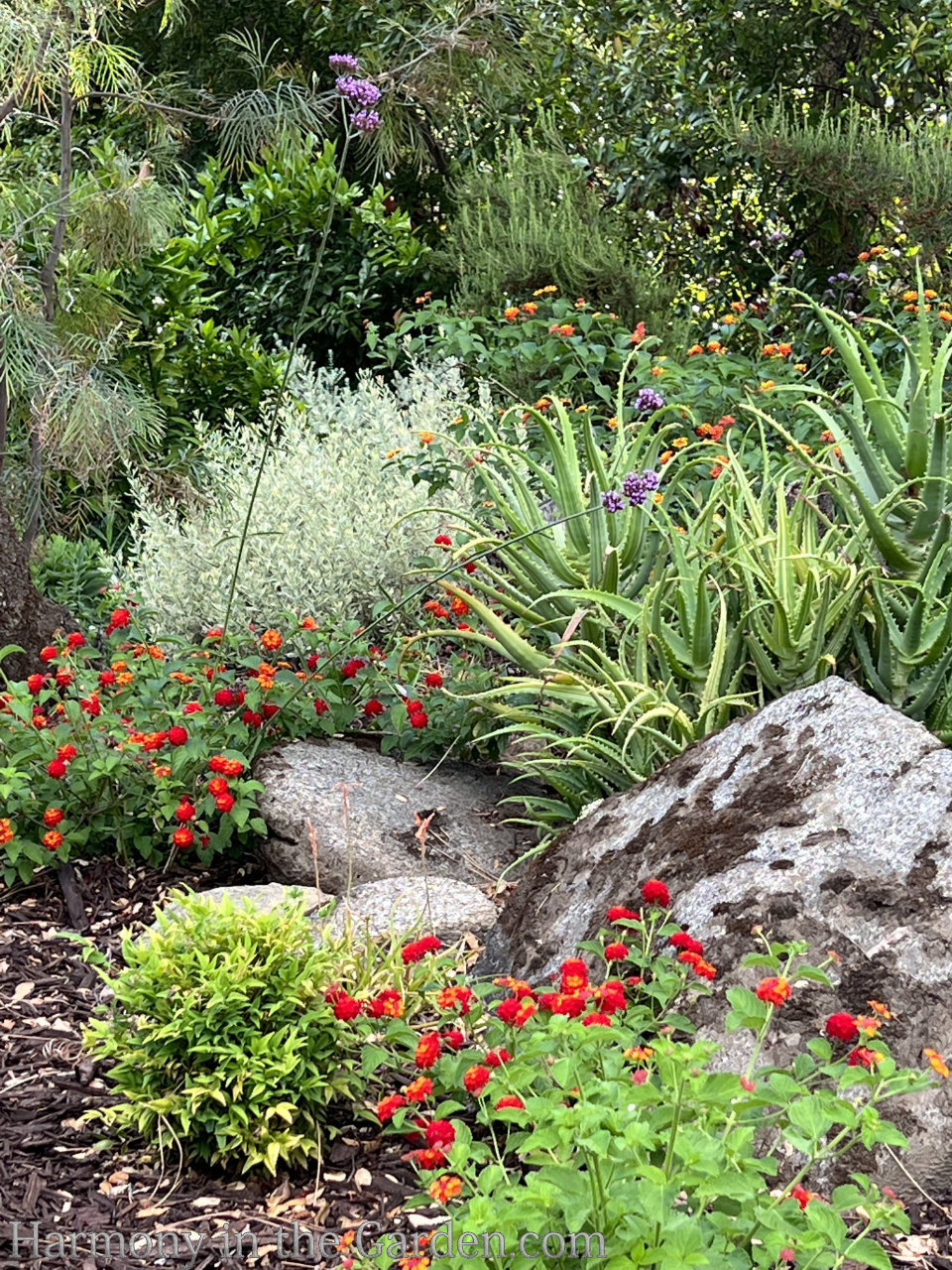
It seems far too many west coast gardeners are jaded by the ubiquitous lantana, and roll their eyes when I mention it.
But honestly, this is one of the most reliable late-summer bloomers there is, and nothing seems to stop it.
It takes the hottest temperatures with a grain of salt.
It thrives with very little water.
Deer and rabbits leave it alone.
And butterflies and hummingbirds adore the blooms.
Not only that, but it comes in a huge range of colors and sizes.
I will admit that lantana is mighty unattractive in the winter, with its brown, dead leaves clinging onto the stems. But c’mon…nothing’s perfect and it’s a small price to pay for all this late summer beauty.
One of my favorite varieties is ‘Dallas Red’ (in the foreground of the photo) as it has the most vibrant, rich reds and oranges I’ve seen.
The taller ‘Radiation’ is in the back, growing to 3-4′ with softer shades of orange and yellow.
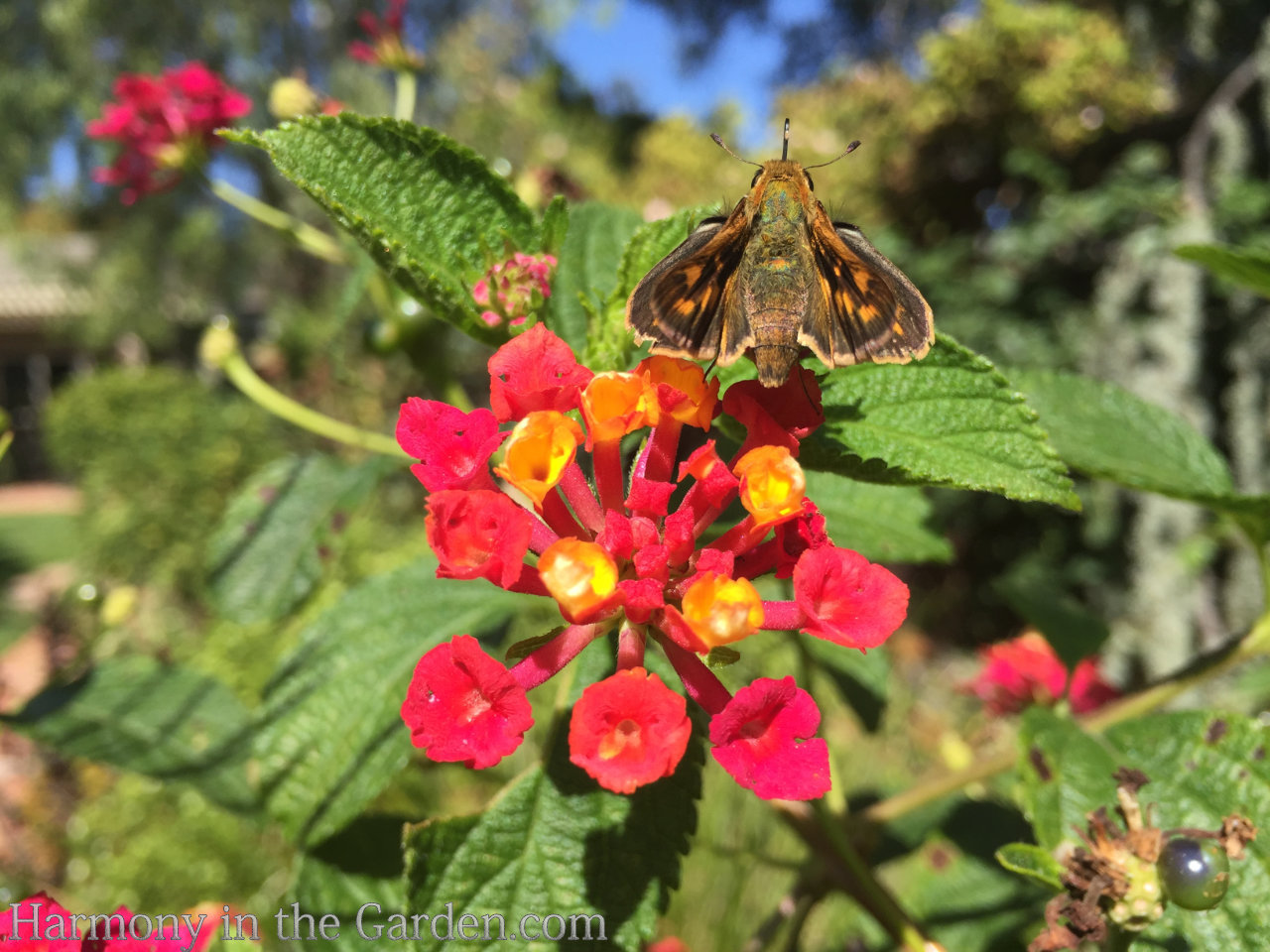
So, to those who might be groaning with my commonplace suggestion, I dare you to walk outside this time of year, look at the butterflies feasting on the flowers, and not think to yourself , ‘wow, Rebecca was right – this IS an awesome plant!”
Okay, that’s all for now. Please share any of your favorite late-summer beauties – we’d all love to learn!!!






15 Comments
Thank you, Rebecca, for all of the time, effort, and love that you put into your postings for us garden lovers! It is always such a treat to find your email and spend some time reading and looking at your wonderful photos. My native CA fuschia is putting on its show, too. What is the best way to take care of it after it finishes? Should it be cut back in the winter?
Hi Marilee, what a nice thing to say – thank you for making my night! 🙂 I’m not sure which variety you have, but in my gardens I like to use ‘Everett’s Choice’ and if I don’t cut them back hard in the winter, they look pretty scraggly. Sometimes it might seem like they won’t bounce back, but if they don’t, they’ll often send out runners that develop into their own beautiful mounds in a year or so. Maybe experiment a bit with yours – try and cut them by half and see how they look and maybe cut another one even harder to see what works best. Good luck!
Thank you, Rebecca! 😊
A new word- Serotinal, and lots of get plants ideas for this period. Thanks Rebecca!
So glad you liked it, Jim! Here’s the other ‘seasons’ for an upcoming presentation topic: prevernal, vernal, estival (summer), serotinal (late summer), autumnal, and hibernal.
Hi Rebecca,
so good to read your blog as always. I just ordered three of the Henry Eilers, they are adorable. Since you found them up here in WA, I assume they will work in my garden on Bainbridge Island. I’ll try to see you in May at the Bellevue Gardens. And know that you are always welcome here when you visit the area.
That’s wonderful, Gigi! The ‘Henry Eiler’s should do amazingly well in your garden. It’d be great to see you in May, let’s definitely touch base so I can finally see your garden in person! Very overdue. 🙂
Hi Rebecca, I always enjoy reading your blog and always come away with some new design concept or some new plant to me to consider. In reply to your question about growing Mexican Sunflower from seed, I have had success. Maybe not 100% germination rate but enough to be content. Even though these seeds are pretty small I do soak them overnight in water. Then plant them in raised veggie beds to help with pollination. You do have to keep the soil moist for a number of weeks while they get started. This year I planted them beside Sunsugar Yellow Cherry Tomato. It is a nice combination. A number of my neighbors/friends have commented how much they like Mexican Sunflower. These annuals reach 4-6′ height so you won’t be disappointed. Give them a try.
Hi Tami, thanks so much for the kind words re: my blog and for the great info about starting tithonia from seed. You’ve inspired me to definitely try some this year and I’ll keep my fingers crossed they germinate! I love your idea of combining them with the tomatoes – if you have a photo I’d love to see it – definitely thinking outside the box and I bet it looked fantastic!!
Hi Rebecca,
Love your site! I’m in the Bay Area, so a bit cooler. I mostly plant natives. For blooms at this time of year, our native verbenas, island bush poppy, and coyote mint are all blooming. I also have yarrow and monkey flower still blooming. And, as you mentioned, the CA fuscia are just starting.
Hi Emily, lucky you to be in cooler weather! I lived in Los Altos until 4 years ago when we moved to Granite Bay where it’s MUCH hotter. Your garden sound beautiful, and thanks for the reminder to find some island bush poppy – one of my favorite natives ever!
Trina, some of our California native plants have the most wonderful scents in the world, in my opinion. Hummingbird sage (which does well in some shade), coyote mint, sagebrush, and especially the California sages (Salvia) smell amazing after a rain or watering. These are very low water as well, perfectly adapted to our climate. Have fun in your exploration!
Yes, Janny – excellent suggestions!! As I was just taking my dog outside one last time before bed, I brushed past my lime-scented thyme (it’s about 2’x2′, evergreen, and wonderfully scented.) I’d recommend those, too – low water, appreciates a bit of afternoon shade, and smells heavenly. Thanks for helping Trina!
Love your site, I am challenged and inspired by your info. Thank you. I am an eighty year old still newby gardener as the years have gone by in many different climate locations. Klamath Falls, Oregon, Murphys, CA, Mission Viego, CA., Many different climate zones. Am now residing in a Senior Mobile Home Park in Davis, CA. A beautiful site with a large variety of very mature trees. My desire is to have as much variety as possible with grasses and other backfillll grasses to display a single plant. I want to focus on fragrance as I find that absent in gardening books. Also Old English Roses with Fragrance. Thinking Gardenias, Camelias, Nastursiums, Asters, Roses (old English), Boston Ivy, pansies, sweet peas, fountain grass, dusty miller, ground covers… dichondra, thyme, baby tears, …I am open to anything that will thrive in HOT Davis, CA….I have lots of ideas and little knowledge…..ALL imputs are welcome. My plot is about 60 feet by 20 feet,, a typical Mobile Home Lot.
Hi Trina, I’m so glad you enjoyed my post and happy to hear about your plans for your new garden! I would imagine anything that can grow in my climate would be able to grow in yours, so you might use my search bar (on my blog’s main page) to search for ‘drought tolerant’, etc. to give you more ideas. You might also try my ‘before-and-after’ posts (you can find them under the ‘category’ search bar, which is also in the main blog page sidebar. I hope that helps and gives you lots of ideas – the plants you mentioned are all some of my favorites!